Q1 2011 Productivity & Costs was revised today. Labor productivity increased +1.8%. Output increased +3.2% and hours worked increased 1.4%. From Q1 2010, annual productivity increased +1.3%, output +3.2% and hours +1.9%. Below is business, nonfarm labor productivity per quarter. Workers are still being squeezed, and with such high unemployment, we need productivity to dramatically decline, forcing U.S. businesses to hire more workers.

The basic equation for labor productivity is , where
is the total output of industry.
How does the DOL calculate labor productivity?
Labor productivity is calculated by dividing an index of real output by an index of the combined hours worked of all persons, including employees, proprietors, and unpaid family workers.
, or Labor, is measured in hours only. Both values are normalized to a base year, 2005. Output directly correlates to real GDP, minus the government, all of those nonprofits and our infamous, often illegal nannies and gardeners. The output, or
is about 75% of real real GDP reported. Farms, if you can believe this, only subtract off about 1% from Output totals. Labor productivity is reported annualized. The main productivity numbers above are all business, no farms. This does include the manufacturing sector.
Annual nonfarm business productivity yearly change, was 1.8% and the quarterly change from one year ago is 1.3%.
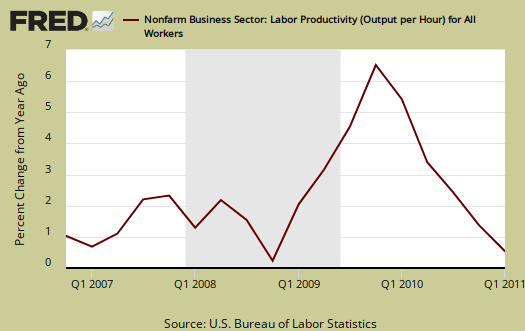
Graphed below is the unit labor costs, compounded annual rate, percent change. Unit labor costs increased 0.7% for Q1 2011 and from Q1 2010, are also up 0.7%.
BLS defines unit labor costs as the ratio of hourly compensation, , to labor productivity,
, or
. For more formula definitions see the BLS handbook. From the report is the relationship of the ratios:
BLS defines unit labor costs as the ratio of hourly compensation to labor productivity; increases in hourly compensation tend to increase unit labor costs and increases in output per hour tend to reduce them. Real hourly compensation is equal to hourly compensation divided by the consumer price series.
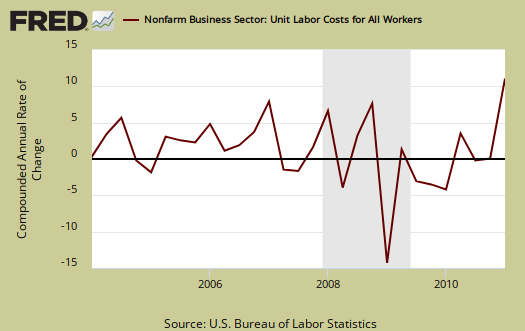
Graphed below are unit labor costs, indexed to 2005. Notice the decline starting in the Great Recession, that's right, we're becoming mega cheap.
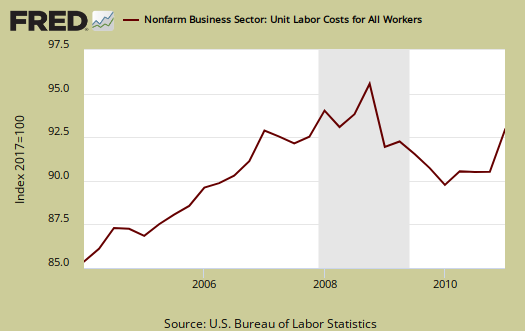
Real hourly compensation is equal to hourly compensation divided by the consumer price series, or .
Yet the consumer price series, , increased at a 5.3% annual rate, so in terms of real dollars, adjusted for inflation, we have a -2.6% decline in real hourly compensation. This implies workers are being squeezed and squeezed. Wages are not keeping up with inflation. Below are quarterly changes unit labor costs, adjusted for consumer prices. You can see the rise and fall with deflation and inflation. Bottom line, inflation is not turning into increased wages.
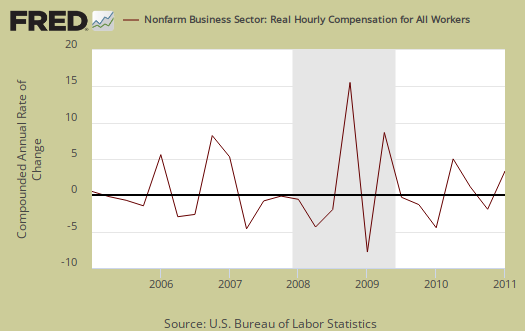
The BLS also reports separately on manufacturing productivity, but uses a different calculation method than the one for business productivity. So, don't think ya can subtract the below and get services productivity, the two ain't the same.
Manufacturing is sales, removing duplicates, adjusting for prices and output () is correlated to shipments and the industrial production. indexes. Hours are hours like above. Page 4 of the report has the manufacturing productivity measurement nitty gritty.
Manufacturing productivity increased +4.2% in Q1 2011, manufacturing output increased +7.7% while hours worked increased 3.3%. For the yearly average of the last 4 quarters, manufacturing productivity is up 4.1%.

Manufacturing unit labor costs are down -1.4% for Q1 2011 and are down -0.7% for the last 4 quarters. This is bad news for workers, they are outputting more with less workers (in the United States).
Productivity increased 7.5% in the durable goods sector and 2.6% in the nondurable goods sector in the first quarter of 2011. In durable goods industries, a 14.0% jump in output outweighed a 6.1% increase in hours worked. Nondurable goods production rose 1.5 percent while hours fell 1.1%.
Real compensation (wages) in manufacturing decreased -2.4% for Q1 2011, even though compensation per hour, not adjusted for inflation, increased 2.8%. Manufacturing isn't keeping up with inflation either.
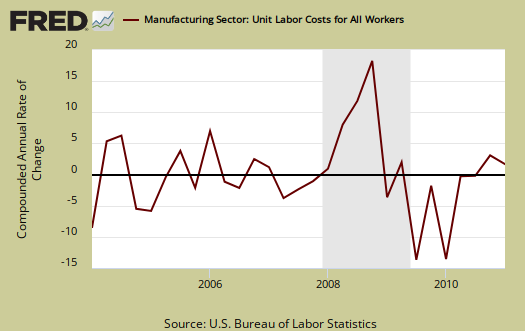
What you see these days in productivity is not what it appears. The press will claim increased productivity is a great thing, but it's clearly not translating into wages and jobs for workers.
While leads me to this paper from the Monthly Labor Review, The compensation-productivity gap: a visual essay. Now these are the people who maintain the BLS productivity statistics. In the report, they go over their methods, calculations, which can make a huge difference in results. Bottom line they show since the 1970's, workers are getting less and less of the labor share or payout, less of a slice from the American pie called increased economic output. What they found was most of the productivity vs. how much you get in your pocket to spend gap before year 2000 could be attributed to a couple of different measures for inflation. After 2000, the gap is because workers are getting screwed. From the paper:
Labor share is a measure of how much of the economic pie goes to all workers. When labor share is constant or rising, workers benefit from economic growth. When labor share falls, the compensation–productivity gap widens. Concurrently, nonlabor costs—which include intermediate inputs into production and returns to investments, or profits—represent a greater share of output.
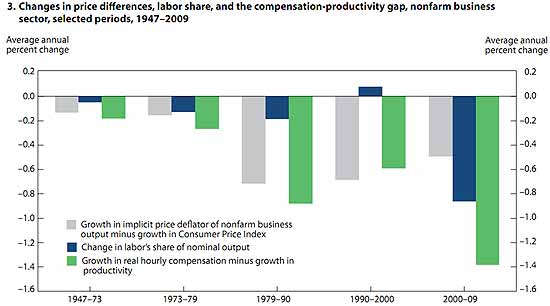
Their paper is loaded with graphs, but the above was reprinted for it shows clearly, since 2000, American workers are simply getting shafted while those making the profits are taking it to the bank.
Here is the Q4 2010 productivity report overview, unrevised.

real compensation per hour, two quarters of plunge
The BLS doesn't use straight CPI-U to calculate real compensation per hour, they use CPI-U-RS, which is a research metric, which ended in 2010 and extrapolate via the same slope for Q1 2011 the values.
I didn't compare all of the percentage differences between the two indexes, but it appears to be lower slightly than CPI-U and there are details on the BLS website.
But bottom line, two major whammies for workers.
Q4 2010 had a strong rise in inflation and then in Q1 2011 the BEA/BLS revised downward actual wages...
Basically that's a major worker squeeze in terms of how far their meager earnings go.